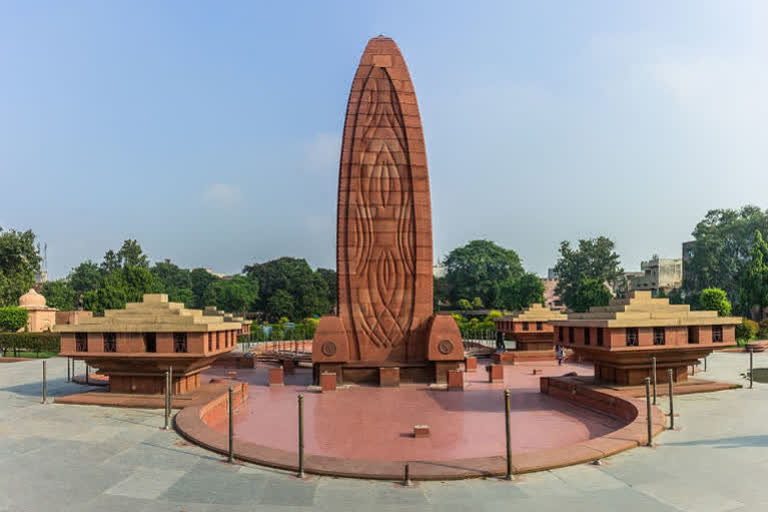Amritsar: The Jallianwala Bagh massacre of April 13, 1919 is being regarded as the turning point that clearly drove the struggle for Indian Independence to fruition. Much blood was spilled in a single incident of otherwise non-violent struggle for the freedom from the British. On the 103rd anniversary of the Jallianwala Bagh massacre, let us take a look at what led to the gory episode in India's struggle for independence.
Before the massacre, so much was brewing in the North-Western frontier of British India. The Gadar Movement of 1913 and the Komagata Maru incident of 1914 had started a wave of revolution among the people of Punjab. When the first World War broke out in 1914, many Indian soldiers were enlisted to fight on the European side.
Among 1.95 lakh Indian Soldiers in the British Army fighting in the great war, as many as 1.1 lakh were from Punjab. Nationalism and patriotism were emerging among these soldiers who ventured out of the country for the first time to Europe. They had now seen the world and knew what a country meant.
As for the Britishers, they were afraid that if these soldiers revolted, it would be difficult to control them. The government did not have any strict laws to stop them. Given the changing environment in Punjab, the British deliberated on a new law as a result of which the controversial 'Anarchical and Revolutionary Crimes Act of 1919' popularly known as the Rowlatt Act — named after Sidney Rowlatt, the president of the committee that came up with the Act — came into existence.
Also read: Britain 'deeply regrets' Jallianwala Bagh massacre: UK envoy
The Rowlatt Act provided for indefinitely extending the emergency measures of preventive, indefinite detention and imprisonment without trial. Even at the discussion stage, protests against the law surfaced. The local press started discussing it in detail and protests against the draconian law erupted widely.
Protests took place in many parts of Punjab as well. In Amritsar also scheduled protests were going on. Despite all protests, Rowlatt Act was passed on March 18, 1919. As per Professor Prashant Gaurav, two leaders namely Dr Satyapal Malik and Dr Saifuddin Kichlew were prominent in these protests.
There was an attempt to bring Mahatma Gandhi as well and he in fact left for Punjab on April 2, 1919 but was stopped at Palwal and sent back. Sensing trouble, British decided to stop these two leaders leading the protests. Amritsar District Commissioner, Miles Irving called Satyapal and Kichlew to his office on April 10, 1919 but arrested them treacherously.
They were moved away from Amritsar and placed under house arrest at Dharmashala. Tensions simmered in Amritsar after the arrest of these two senior leaders. More than 20,000 people protested in Katra Jaimal Singh, Hall Bazaar and Ucha Pul area. After a couple of violent incidents, Lieutenant Governor of Punjab Michael O'Dwyer had called Army officer General Reginald Dyre from Jalandhar Cantonment board to handle the situation. Dyre, on his part had a caustic view about Indians, said Gaurav.
A day before the Jallianwala Bagh massacre, General Dyre marched in Amritsar with his entire armed forces and announced a curfew. Most of the local residents did not even know what a curfew was. Unaware of the curfew, people gathered for a meeting at Jallianwala Bagh. Apart from this, on the day of Baisakhi, pilgrims from far had reached Sri Harmandir Sahib to pay obeisance.
Traders coming to participate in Gobindgarh Pashu Mela were also present there. When the preparations for the protest meeting were going on in Jallianwala Bagh and microphones were set up, these unassuming people thought that some event was about to happen. The meeting which was scheduled at 4-4:30 PM started at 3 pm considering the huge crowd.
All this while, Dyer was getting every update from the people posted on the ground. Around 5 -5:15 pm General Dyre arrived at the Jallianwala Bagh with 4 detachments of 25 soldiers. With 50 soldiers of Gorkha Regiment and Afghan Regiment, General Dyre entered the Bagh and immediately ordered to shoot.
The firing started precisely at 5.30 pm, said, Professor Prashant Gaurav. There were no warning shots fired or efforts made to disperse the crowd, Gaurav said. People were shot directly and 1650 rounds of .303 calibre were fired and people started falling dead. When people saw the dead and wounded, the stampede started as people tried to flee the spot. The well inside the ground was filled with dead bodies.
Initially, O' Dwyre reported that 200 people were killed out of 5000 people present inside the ground. Punjab Chief Secretary J P Thomson writes that 291 people were killed among which 211 were from Amritsar city. As per Hunter committee, 379 people were killed in the incident. "It is very strange and needs to be understood that it says that 275 people died from bullets, 104 dead bodies were recovered from the well," Gaurav added.
Madan Mohan Malviya was head of the Inquiry Committee on the incident and he said that 1000 people were killed in the massacre. Congress Inquiry Committee estimated the killings at 1200 saying 2600 were injured. Swami Shradhanand also went there and he said that 1500 people died.
"So in total, the data is in between 1000-1500. It is Britisher's record that kept on increasing but 379 is not right in any way. Overall it can be said that how many people got killed is not clear but one thing is for sure that thousands of people got killed," Gaurav observed. After the outrage of the Indians, the British government had to suspend General Dyer, who quietly returned to Britain.
Martyr Udham Singh avenged the massacre by shooting Michael O'Dwyer in London on March 13, 1940. In 1961, the Government of India erected a memorial to pay homage to departed souls, which was inaugurated by the first President of free India, Rajendra Prasad.
